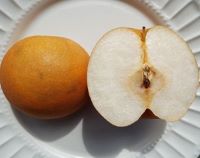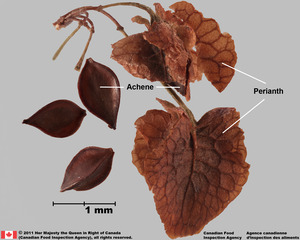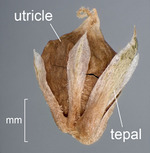Content is from Kirkbride et al. 2006Kirkbride et al. 2006:
Kirkbride JH, Jr, Gunn CR, and Dallwitz MJ. 2006. Family guide for fruits and seeds, vers. 1.0. Accessed September 2020-January 2022. URL: https://nt.ars-grin.gov/seedsfruits/keys/frsdfam/index.cfm ., without modification.
Updates are forthcoming.
Fruits: Pistil(s) simple, or compound; 1; 1-pistillate; with carpels united. Fruit anthocarpanthocarp:
simple or compound and including some tissue of non-ovarian origin (accessory tissue) ; simple; pomepome:
; simple; pomepome:
an indehiscent, fleshy fruit with accessory floral tube tissue adnate to the pericarp, outer wall thick and fleshy, interior contains papery or cartilaginous structures enclosing the seeds, derived from a single, inferior, compound ovary (Spjut 4 families: Idiospermaceae, Olacaceae, Rhamnaceae, Rosaceae); without persistent central column; with styles(s); at apexapex:
(Spjut 4 families: Idiospermaceae, Olacaceae, Rhamnaceae, Rosaceae); without persistent central column; with styles(s); at apexapex:
the point farthest from the point of attachment, or the "tip" of an organ ; within accessory organ(s); within hypanthium; accrescentaccrescent:
; within accessory organ(s); within hypanthium; accrescentaccrescent:
growing continuously
; persistent; with hypanthium composed of 2 layers; with hypanthium hard layer over soft layer; with hypanthium fleshy (olive-brown); 1–2-seeded; from 5.1–10 cm long; 5–5.5 cm long; with 1–2-carpellate (3?); with carpels united; with carpels remaining united at maturity; without sterilesterile:
lacking male and/or female reproductive parts; also, not producing fruit or seed
 carpels; not sulcatesulcate:
carpels; not sulcatesulcate:
surface relief—having one or more elongate, relatively narrow and shallow depressions or grooves ; in transection tereteterete:
; in transection tereteterete:
approximately circular in cross section; width and thickness approximately equal
 ; apexapex:
; apexapex:
the point farthest from the point of attachment, or the "tip" of an organ not beaked; indehiscentindehiscent:
not beaked; indehiscentindehiscent:
not opening on its own, as in a fruit
 . Epicarpepicarp:
. Epicarpepicarp:
outer layer of fruit wall or pericarp, if divided into layers; note here used synonymously with exocarp durable; glabrousglabrous:
durable; glabrousglabrous:
without hairs
; without armature; without wing(s); without apicalapical:
at or pertaining to the end of the seed or fruit distal from its point of attachment (i.e., base)
respiratory hole. Mesocarpmesocarp:
the middle layer of the pericarp, if divided into layers present; fleshy; composed of 1 unified layer; without lactiform cavity system. Endocarpendocarp:
present; fleshy; composed of 1 unified layer; without lactiform cavity system. Endocarpendocarp:
the inner layer of the pericarp, if divided into layers present; not separating from exocarpexocarp:
present; not separating from exocarpexocarp:
outer layer of fruit wall or pericarp, if divided into layers; note here used synonymously with epicarp ; thin (but not Spjut), or crustaceouscrustaceous:
; thin (but not Spjut), or crustaceouscrustaceous:
texture—thin, dry, indurate, and brittle
, or bonybony:
very hard and rather brittle, like bone
(latter 2 Spjut for his drupedrupe:
(indehiscent drupe) a fleshy, indehiscent fruit with one more hard pits enclosing seeds, derived from single, superior, simple or compound ovary; (dehiscent drupe) a fruit with a dry or fibrous to fleshy or leathery outer husk that early to tardily breaks apart (or opens), exposing one or more nutlike pits enclosing the seeds ); not splitting into 1-seeded pyrenes; smooth; without wing; without operculumoperculum:
); not splitting into 1-seeded pyrenes; smooth; without wing; without operculumoperculum:
a dehiscent cap (or lid) of a seed or fruit that opens during germination or dehiscence ; without secretory cavities; without mechanism for seedling escape; without grooves; without longitudinallongitudinal:
; without secretory cavities; without mechanism for seedling escape; without grooves; without longitudinallongitudinal:
of or relating to length or the lengthwise dimension
ridges. Funiculusfuniculus:
(alt. funicle) stalk connecting the ovule (later seed) to the ovary (later fruit) placenta short; short without seed bearing hookswith hooks:
short; short without seed bearing hookswith hooks:
bristles or spines with curved or backwards pointing tips, or with secondary bristles along their length (retinacula); not persisting in fruit after seed shed.
(retinacula); not persisting in fruit after seed shed.
Seeds: Arilaril:
(broad sense) appendicular structure that wholly or partly envelops a seed and is produced from or a modification of the funicle, raphe, or outer integument; usually fleshy or pulpy, sometimes spongy or tufted-capillate, often brightly colored absent. Seed larger than minute; 25 to less than 50 mm long to 50+ mm long; 40–50 mm long; circularcircular:
absent. Seed larger than minute; 25 to less than 50 mm long to 50+ mm long; 40–50 mm long; circularcircular:
(of embryo) linear embryo is curved into an "O" shape ; in transection tereteterete:
; in transection tereteterete:
approximately circular in cross section; width and thickness approximately equal
 ; not bowl shaped; not nutlike; without winglike beakbeak:
; not bowl shaped; not nutlike; without winglike beakbeak:
a usually firm, terminal appendage, sometimes tapered ; without caudatecaudate:
; without caudatecaudate:
tapering to a long, tail-like appendage appendage(s); at maturity without food reserves; without canavanine. Sarcotestasarcotesta:
appendage(s); at maturity without food reserves; without canavanine. Sarcotestasarcotesta:
pulpy or fleshy outer layer of the seed coat, simulates aril absent. Testatesta:
absent. Testatesta:
seed coat
 present, or absent; adnate to epicarpepicarp:
present, or absent; adnate to epicarpepicarp:
outer layer of fruit wall or pericarp, if divided into layers; note here used synonymously with exocarp ; without embryo surrounded and capped by viscid tissue; without markedly different marginalmarginal:
; without embryo surrounded and capped by viscid tissue; without markedly different marginalmarginal:
at, on, or close to the margin or border
tissue; without fleshy or leatheryleathery:
texture—moderately thick, tough, and very pliable
layer over hard layer; tight; shinyshiny:
uniformly reflecting a high proportion of incident light at all angles ; without crease or line separating cotyledons from hypocotyl-radicle; without notch along margin where cotyledons from hypocotyl-radicle tip approach each other; without glands; without bristles; glabrousglabrous:
; without crease or line separating cotyledons from hypocotyl-radicle; without notch along margin where cotyledons from hypocotyl-radicle tip approach each other; without glands; without bristles; glabrousglabrous:
without hairs
; without wings; without collar; without operculumoperculum:
a dehiscent cap (or lid) of a seed or fruit that opens during germination or dehiscence ; colored; monochrome; membranousmembranous:
; colored; monochrome; membranousmembranous:
texture—extremely thin, pliable, and fairly tough
; not becoming mucilaginousmucilaginous:
resembling mucilage; moist and sticky
when wetted; surrounding embryo. Hilumhilum:
on seeds, the scar indicating where the funiculus was attached; on grass caryopses, the scar visible on the outer fruit surface revealing where the seed is attached on the inner fruit wall surface; or in Asteraceae cypselae, the scar visible on the outer fruit wall revealing where the fruit was attached to the receptacle larger than punctatepunctate:
larger than punctatepunctate:
surface relief—dotted with pits or with translucent, sunken glands or with colored dots, similar to pitted (assumed). Embryo differentiated from food reserve (no endosperm); well developed; 1 per seed; completely filling testatesta:
(assumed). Embryo differentiated from food reserve (no endosperm); well developed; 1 per seed; completely filling testatesta:
seed coat
 (no food reserve); at one end of seed not extending into a depression or cup; foliatefoliate:
(no food reserve); at one end of seed not extending into a depression or cup; foliatefoliate:
appearing leaf-like
; with investinginvesting:
(of embryo) embryo is nearly or completely filling seed coat, straight, and axile and centric with spatulate cotyledons and covering the stalk for at least half its length; (of cotyledons) cotyledons spatulate and covering the stalk for at least half its length
cotyledons; with cotyledons abruptly connected to hypocotyl-radicle; without coleorhiza; without simmondsin; without stomata; not green; with 2 or more cotyledons. Cotyledons 3 to 4; well developed; 0.9 times length of embryo (estimated); somewhat to significantly wider than hypocotyl-radicle; 10 times wider than hypocotyl-radicle (or more,estimated); entirely concealing hypocotyl-radicle to partially concealing hypocotyl-radicle; not foliaceous; massive; smooth; with apicesapex:
the point farthest from the point of attachment, or the "tip" of an organ entire; with margins separate; basally entire; equal in size; not punctatepunctate:
entire; with margins separate; basally entire; equal in size; not punctatepunctate:
surface relief—dotted with pits or with translucent, sunken glands or with colored dots, similar to pitted dotted. Hypocotyl-radicle small; straight; not thickened. Plumule moderately developed; straight.
dotted. Hypocotyl-radicle small; straight; not thickened. Plumule moderately developed; straight.
This fruit technically does not meet the Spjut description as follows: An indehiscentindehiscent:
not opening on its own, as in a fruit
 simple fruit composed of a fleshy to coriaceouscoriaceous:
simple fruit composed of a fleshy to coriaceouscoriaceous:
texture—leathery
exocarp, the fleshy layer primarily formed by receptacle, hypanthium, or perianthperianth:
collective term for calyx and corolla of a flower
 ". Idiospermum has brittle receptacle. Mabberley: Fruit large, more or less globoseglobose:
". Idiospermum has brittle receptacle. Mabberley: Fruit large, more or less globoseglobose:
3D shape—more or less spherical , indehiscentindehiscent:
, indehiscentindehiscent:
not opening on its own, as in a fruit
 , the receptacle becoming hard without, fleshy within and more or less closed apically by persistent perianthperianth:
, the receptacle becoming hard without, fleshy within and more or less closed apically by persistent perianthperianth:
collective term for calyx and corolla of a flower
 and stamen, pericarppericarp:
and stamen, pericarppericarp:
fruit wall or fruit coat
thin and adpressed to receptacle. Cronquist: Fruit "large, globoseglobose:
3D shape—more or less spherical or depressed globoseglobose:
or depressed globoseglobose:
3D shape—more or less spherical , indehiscentindehiscent:
, indehiscentindehiscent:
not opening on its own, as in a fruit
 , the hypanthium becoming somewhat fleshy with a tiny, hard outer layer, essentially closed at the top by the persistent stamens and upper or inner tepalstepal:
, the hypanthium becoming somewhat fleshy with a tiny, hard outer layer, essentially closed at the top by the persistent stamens and upper or inner tepalstepal:
a member of the perianth, when it cannot be differentiated into a calyx and corolla , the pericarppericarp:
, the pericarppericarp:
fruit wall or fruit coat
itself relatively thin and appressedappressed:
pressed close to or lying flat against something, as in hairs on grass bract
to (but distinct from) the hypanthial wall. Seed 1". Pomepome:
an indehiscent, fleshy fruit with accessory floral tube tissue adnate to the pericarp, outer wall thick and fleshy, interior contains papery or cartilaginous structures enclosing the seeds, derived from a single, inferior, compound ovary maybe correct, but check Blake (1972). Cotyledons peltate.
maybe correct, but check Blake (1972). Cotyledons peltate.
Literature specific to this family: Blake, S.T. 1972. No.12. Idiospermum (Idiospermaceae), a new genus and family for Calycanthus australiensis. Contr. Queensland Herb. 12:1–37.
General references: Cronquist, A. 1981. An integrated system of classification of flowering plants, 1,262 p. Columbia University Press, New York, Goldberg, A. 1986 (dicots) & 1989 (monocots). Classification, evolution, and phylogeny of the familes of Dicotyledons. Smithsonian Contr. Bot. 58 for dicots (314 pp.) & 71 for monocots (74 pp.). [Goldberg's illustrations are reproduced from older publications and these should be consulted], Gunn, C.R., J.H. Wiersema, C.A. Ritchie, & J.H. Kirkbride, Jr. 1992 & amendments. Families and genera of Spermatophytes recognized by the Agricultural Research Service. Techn. Bull. U.S.D.A. 1796:1–500, Mabberley, D.J. 1987. The plant-book, 706 p. Cambridge University Press, Cambridge, and Spjut, R.W. 1994. A systematic treatment of fruit types. Mem. New York Bot. Gard. 70:1–182.